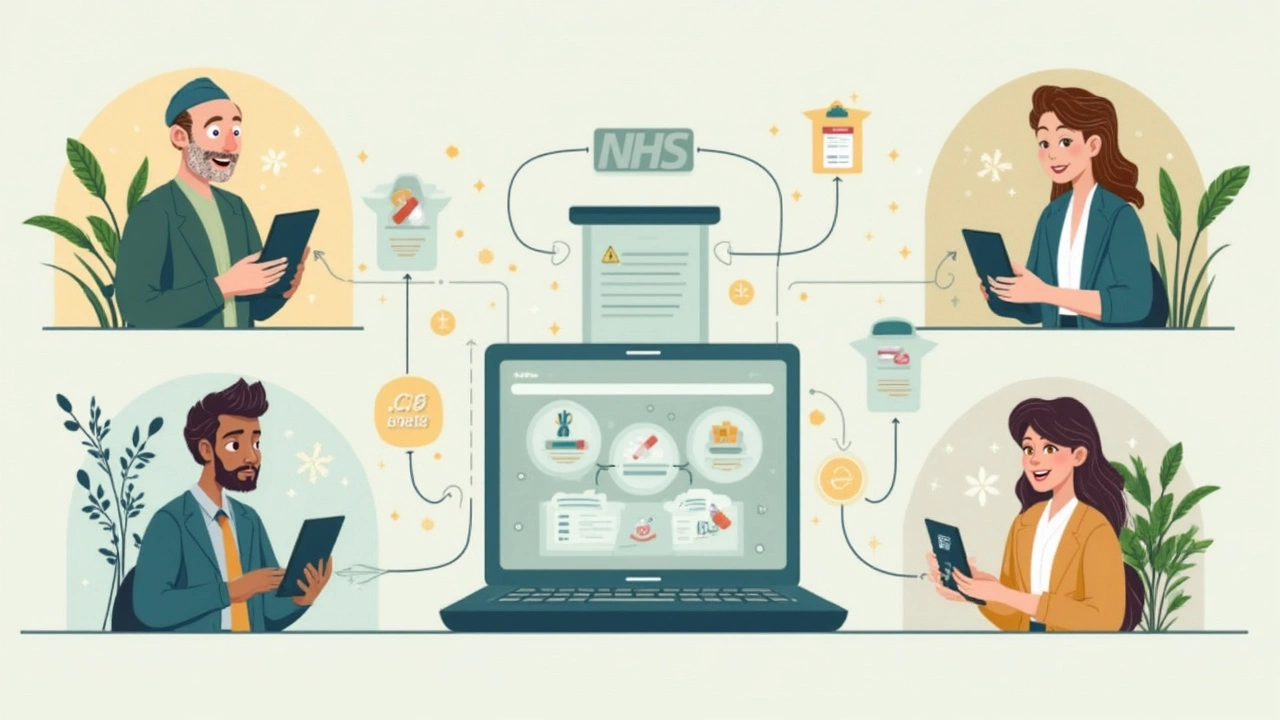 May, 13 2025
May, 13 2025
Wondering if you can skip the doctor’s office and just get a prescription online? Short answer: Yes, you often can. But, there’s a catch—maybe a few. Most legit online prescription services will connect you to a real doctor over video or a text-based chat before they write anything. You don’t have to sit in a waiting room with outdated magazines, but some form of virtual visit is nearly always part of the process.
These virtual clinics are everywhere now. Some focus on urgent stuff like a sinus infection or a rash. Others handle routine meds, like birth control or blood pressure refills. It’s fast and way more convenient than booking a regular appointment—just be ready to answer detailed questions about your health. Doctors need this info before giving you any prescription, and online clinics don’t mess around with safety rules.
- How Online Prescriptions Actually Work
- Legal Stuff and Safety Tips
- What You Can (and Can't) Get Online
- Prescription Costs: Online vs. In-Person
- Smart Tips for Using Telemedicine
How Online Prescriptions Actually Work
Scrolling through ads promising instant meds can be tempting. But getting a online prescription isn’t just clicking ‘Buy Now’—there’s a real process behind it. Nearly every legit website or app uses telemedicine rules, so you’re dealing with licensed doctors following strict medical laws. Here’s what actually happens:
- You click to set up a profile—think basic details, your symptoms, maybe a photo or two.
- You fill out a health questionnaire. It’s usually more detailed than the ones at urgent care. Docs want allergies, meds you already take, even when you last visited a doctor in person.
- The site schedules you for a video call, voice call, or a secure online chat with a doctor or nurse practitioner. For some everyday meds—like birth control—they might use asynchronous messaging, but controlled substances always need a live chat.
- The provider reviews your info, may ask follow-up questions, then makes a real medical decision.
- If it’s safe and fits your situation, they send your prescription to your chosen pharmacy, just like regular appointments.
Most online platforms don’t just send you pills directly—they send the order to a physical pharmacy or offer mail delivery through licensed partners. And they keep digital records just like your local clinic.
Not every condition can be treated online. It’s mostly for low-risk health issues or refills of stable meds. Stuff like antibiotics for a UTI, allergy meds, or anxiety refills are common. Anything serious, with red-flag symptoms, probably means you’ll still need to show up in person.
| Condition/Medication | Online Approval Rate |
|---|---|
| Sinus Infection | 85% |
| Birth Control | 95% |
| Blood Pressure Refills | 70% |
| Anxiety Meds | 60% |
| Pain Medications (strong/opioids) | 5% |
Here’s a tip: If a website claims to give you a prescription without a real doctor in the loop, back away. U.S. law says there must be a legit provider-patient relationship. You can ask to see a provider’s credentials if you’re not sure. Most real sites have customer service that’ll walk you through the process before you drop any cash.
Legal Stuff and Safety Tips
Here’s the truth: online prescriptions are legal in most of the U.S., but doctors can’t just email you meds without any contact. Even when you’re not face-to-face in an exam room, you still need a legit appointment—just online. In fact, federal law (the Ryan Haight Act) requires a doctor to evaluate you, usually during some kind of live video call or secure messaging, before they hand out most prescriptions. No real meeting, no prescription. Simple as that.
But watch out. There are plenty of sketchy websites promising miracle pills with zero doctor talk—run from those. Only use licensed platforms based in the U.S. They must use certified healthcare providers and keep your info private (thanks to HIPAA rules). If a website doesn’t clearly show who’s running it or dodges questions about their medical staff, that’s a red flag.
- Make sure the website asks for your medical info and symptoms. If they don’t, they’re not following the rules.
- Check for signs the provider is licensed in your state. U.S. law requires this, even for telemedicine.
- The pharmacy filling your prescription should also be state-licensed—even the online ones.
Data privacy is a big deal, too, especially when you’re sharing health info online. Only use services that mention they’re HIPAA compliant, so your details aren’t up for grabs. If a site offers to ‘speed up’ the process by skipping questions, back out right away.
| Requirement | Is it Legally Required? | Notes |
|---|---|---|
| Live consult with licensed provider | Yes | Video or secure chat okay |
| Licensed pharmacy fills prescription | Yes | Must be U.S.-based (or local) |
| HIPAA-compliant data handling | Yes | Keeps your info private |
| Controlled substances | No (usually) | Most online services won’t prescribe controlled meds |
Here’s something a lot of people don’t know: most online clinics only prescribe common meds and won’t touch things like opioids or Adderall. If you see anyone offering those online without jumping through serious hoops, they’re breaking the law. Stay smart, stick with legit sites, and always check reviews before sharing your info or cash.

What You Can (and Can't) Get Online
This is where things get real. Not every medication is fair game when you use an online prescription service, and the rules aren’t random—they’re about safety and national laws. Here’s the breakdown of what’s usually available and what’s off-limits.
Common Medications You Can Get Online:
- Birth control pills – Most providers can prescribe these after a quick health screening.
- UTI, sinus infection, and skin problem meds – You can often get antibiotics for things like a UTI or acne, as long as you answer health questions and maybe show photos.
- Blood pressure and cholesterol medicine refills – If you’re already on them and just need more, telehealth is usually an option.
- Allergy medication, asthma inhalers (for mild cases) – Common stuff, nothing too heavy-duty.
- ED and hair loss meds – Like sildenafil or finasteride, which are booming online because they’re less embarrassing to ask for virtually.
What You Can’t Get Without Seeing a Doctor in Person:
- Narcotics and controlled substances – Stuff like Adderall, Xanax, or opioid painkillers are tightly watched. Federal law depends on an in-person visit for these, unless some strict exceptions apply (and those are rare).
- New diagnoses for complex conditions – If you’re having chest pain, mental health crises, or a new chronic issue, they’ll usually tell you to go see a doctor in the flesh.
- High-risk medications – Anything that needs regular blood work or close monitoring (think chemotherapy drugs or advanced diabetes treatments) is off the table online.
What’s the reason for all these rules? Doctors want to avoid making mistakes or missing serious symptoms that only show up in a physical exam. Online clinics play it safe because, frankly, nobody wants a lawsuit—or to put someone’s health at risk.
Tip: Always read each service’s FAQ before you sign up. Some telemedicine sites have a handy list of exactly which meds they’re allowed to prescribe in your state (it really can change depending on where you live).
Prescription Costs: Online vs. In-Person
When it comes to prescription costs, the online and in-person worlds can look pretty different. Online services usually charge a flat fee for the virtual visit, which can save money if you don’t have great insurance or if you just want to skip the trip. For something simple, like a telemedicine consult to refill birth control or get antibiotics for strep, you’ll see prices ranging from $20 to $70 per visit.
In comparison, most in-person visits cost a lot more. A basic doctor’s appointment without insurance can run $100–$250, depending on your area. Even if you have insurance, there’s often a copay or a deductible to worry about. Online visits are fast, transparent, and you know what you’ll pay before you start.
Here’s a quick breakdown of typical costs—no surprises:
| Service | Average Cost (with Insurance) | Average Cost (without Insurance) |
|---|---|---|
| Online Prescription Visit | $10–$50 copay | $20–$70 flat fee |
| In-Person Doctor Visit | $20–$40 copay | $100–$250+ |
But here’s something important: Getting the prescription written is just one part. You’ll still have to pay for the medication at your pharmacy, whether the script was written online or face-to-face. Prices for the same drug don’t change based on how the prescription is delivered—but some online services offer mail-order meds or discounts, which can bring costs down.
Some insurance plans love telemedicine and cover more online visits now than ever. Others might not pay anything for a virtual chat. If you’re going the online route, check with your insurer first to see what’s covered. And if you’re paying cash, ask about any discounts or coupon codes—telehealth brands are known for tossing those around.
Tl;dr: The online prescription route can mean quicker visits and lower fees, especially if you’re uninsured. Just watch out for added medication costs, and always double-check if your insurance chips in for virtual care.

Smart Tips for Using Telemedicine
Telemedicine has made getting help way easier, but it’s not foolproof. If you want a smooth ride—and to avoid any nasty surprises on your bill—there are a few things you should always check before you book.
- Online prescription services must operate in your state. U.S. law says the doctor writing your script has to be licensed where you live, so double-check that info.
- Read reviews and look for real doctor profiles. Reputable sites list their healthcare staff with credentials you can verify.
- Don’t skip the fine print about pricing. Some sites charge for the consult, others bundle in the prescription fee, and pharmacy costs are usually extra.
- Get your info ready. Have a list of your current meds, allergies, pharmacy details, and photo ID handy. It can speed things up a lot.
- Ask how long it takes to get your prescription and what happens if there’s an issue—like if your pharmacy can’t fill it or something goes wrong with insurance.
Privacy is a big deal, too. Look for telemedicine services that advertise HIPAA compliance. This means your personal info and health details should be protected the same way they are in a typical doctor’s clinic.
One interesting stat: in 2024, about 38% of all doctor visits in the U.S. were done by video or phone, according to the American Medical Association. And a lot of folks say they saved money on travel and prescription costs just by going digital.
| Tip | Why It Matters |
|---|---|
| Check service licensing | Avoids invalid prescriptions |
| Read pricing details | No surprises in your bill |
| Have info ready | Speeds up your visit |
| Verify privacy standards | Keeps your data safe |
And here’s a quick reality check: not everything can be handled online. If your symptoms are serious or keep coming back, seeing someone in person might actually save you in the long run.
